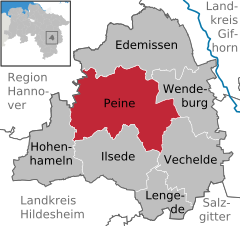Peine
| Peine | ||
|---|---|---|

Market square
|
||
|
||
| Coordinates: 52°19′13″N 10°14′01″E / 52.32028°N 10.23361°ECoordinates: 52°19′13″N 10°14′01″E / 52.32028°N 10.23361°E | ||
| Country | Germany | |
| State | Lower Saxony | |
| District | Peine | |
| Government | ||
| • Mayor | Michael Kessler (SPD) | |
| Area | ||
| • Total | 119.51 km2 (46.14 sq mi) | |
| Population (2015-12-31) | ||
| • Total | 49,366 | |
| • Density | 410/km2 (1,100/sq mi) | |
| Time zone | CET/CEST (UTC+1/+2) | |
| Postal codes | 31224–31228 | |
| Dialling codes | 05171 | |
| Vehicle registration | PE | |
| Website | www.peine.de | |
Peine is a town in Lower Saxony, Germany, capital of the district Peine. It is situated on the river Fuhse and the Mittellandkanal, approx. 25 km west of Braunschweig, and 40 km east of Hanover.
A deed from 1130 mentions Berthold von Pagin, ministerialis of Lothair III, emperor of the Holy Roman Empire, who gave his name to the town in the form of Peine. The castle, Burg Peine, dates to this era or before.
The 1201, the Hildesheim Chronicle describes a feud between the bishop Hartbert von Hildesheim and the brothers Ekbert and Gunzelin von Wolfenbüttel. Earl Gunzelin von Wolfenbüttel was the commander-in-chief of the German army and seneschal in attendance of Otto IV, emperor of the Holy Roman Empire. Gunzelin prevailed and won control of Burg Peine and the surrounding area.
South of the castle, Gunzelin founded the town of Peine in 1218 or 1220. In 1223, the settlement gained town privileges. Gunzelin's coat of arms has been the town's symbol ever since.
In 1256, Peine was conquered by Duke Albrecht of Braunschweig-Lüneburg, and after Gunzelin's death in 1260, his sons lost the fief of Peine to the bishop of Hildesheim.
Otto I of Braunschweig-Lüneburg, bishop of Hildesheim, 1260–1279, gave Earl Wedekind von Poppenburg the castle, town and county of Peine as a fief. Otto later incorporated Peine as a market town.
...
Wikipedia




